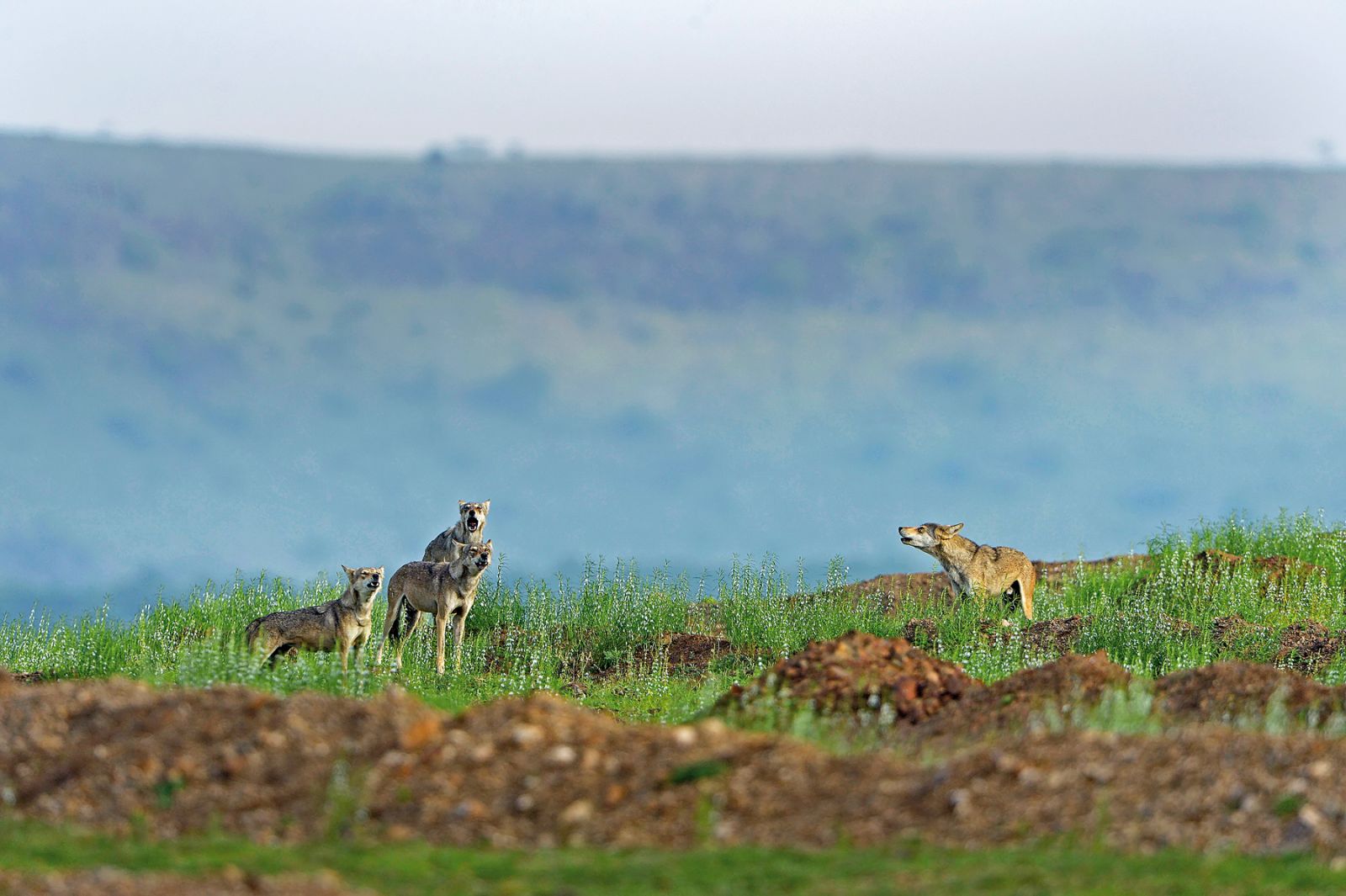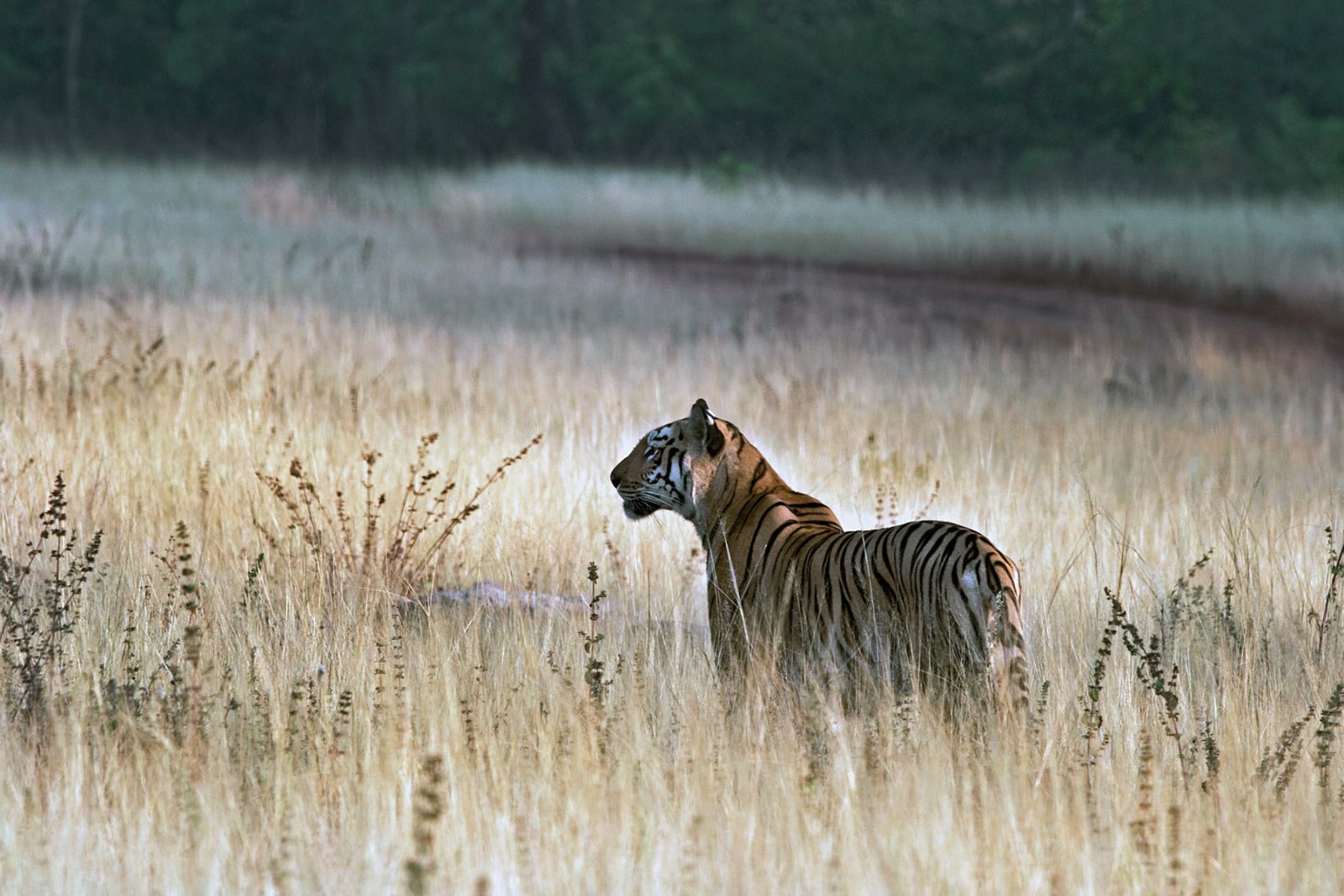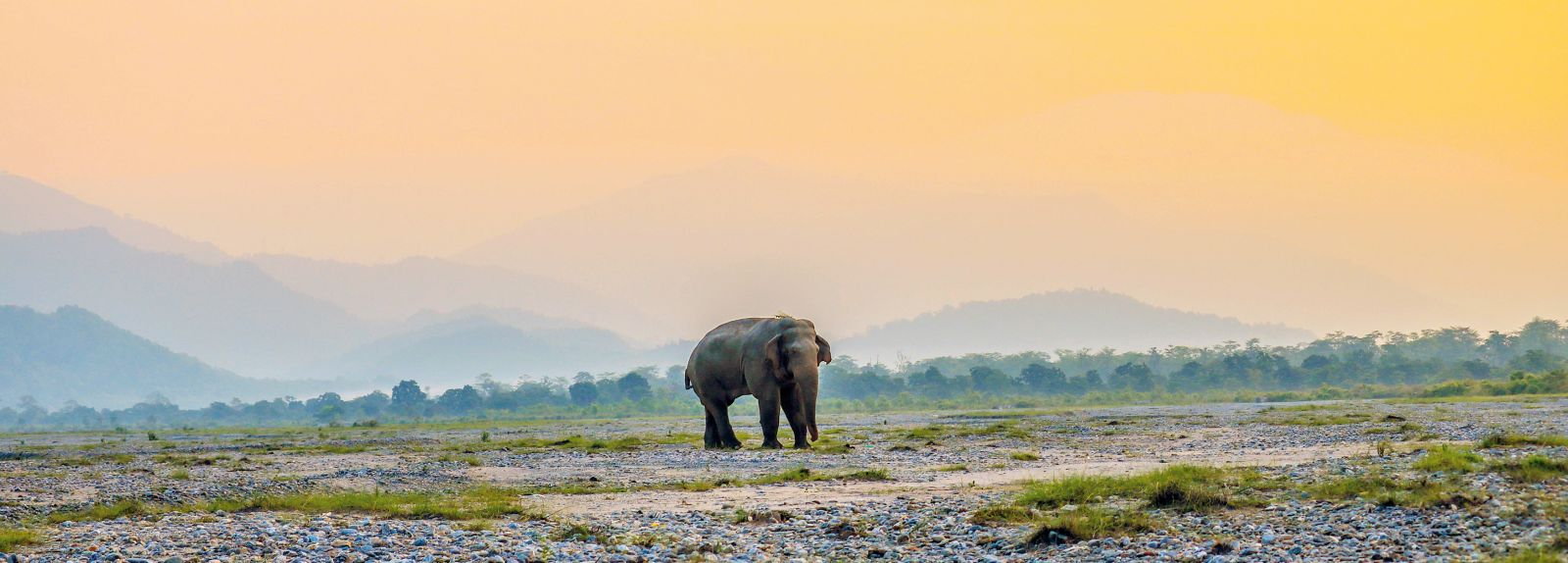The Magic of Grasslands
First published in Sanctuary Asia,
Vol. 39
No. 6,
June 2019
By Subhashini Krishnan
It was close to six in the evening as the western horizon was lit up by the blazing sun. A bright moon rose on the eastern horizon bringing cool winds and mist with it. Standing there, experiencing two of the most common yet brilliant phenomena, I looked around at the huge swathes of grasslands around me. The sunny side showed a palette of yellows, browns, oranges, and reds, while the moonlit side was a monotonous texture of dark green. Around me were porcupine cavities, scuttling mongooses, a herd of ruminating nilgai, and a symphony of insects and roosting birds. These enigmatic operations of the meadow held me rooted to my spot and left me wondering whether this picture-perfect image of one of the last remaining grasslands of the Tadoba-Andhari Tiger Reserve would be able to survive in the decades ahead.
 Though cliched, the slogan ‘Grasslands are not wastelands’ needs to be drummed into the heads of planners who are unable to comprehend the ecological services these vital ecosystems offer. Meanwhile, the clouds of ‘development’ close in to threaten landscapes that enabled the rise of the mammals. Photo: Vikram Potdar
Though cliched, the slogan ‘Grasslands are not wastelands’ needs to be drummed into the heads of planners who are unable to comprehend the ecological services these vital ecosystems offer. Meanwhile, the clouds of ‘development’ close in to threaten landscapes that enabled the rise of the mammals. Photo: Vikram Potdar
Endangered, Misunderstood, Undervalued
The antiquity of grasslands is little understood by people, including decision-makers who undervalue these miraculous ecosystems that need protection, not ‘improvement’. They did not become fallow lands lying in wait of development. Nor are they wastelands, dump sites or lands just waiting for someone to turn into fields and farms.
One of our planet’s most vital biomes, grasslands (dominated by plants from the Poaceae family) have been around since the Cretaceous period and play a significant but greatly devalued role in maintaining life on Earth. Nothing explains this better than the way grasslands are named. Grasslands are referred to as ‘Banjar Bhoomi’ in Hindi, ‘Porambokku Nilam’ in Tamil, ‘Khil Bhoomi’ in Bengali, ‘Padik Jamin’ in Marathi - all denoting spaces that are ‘wastelands’ or ‘infertile lands.’ It is no surprise that they are the first victims of agricultural expansion and the first choice for waste dump-sites. Even worse, planners often see grasslands as degraded ecosystems, ‘ripe’ for planting trees such as eucalyptus, teak, Prosopis juliflora, tecoma, and poplars. In the process, we end up destroying one of the planet’s most unique habitats that sustain a splendiferous ecosystem.
Such plantations were driven by commercial ambitions, a false sense of aesthetics, mistaken notions of environmental protection, and misguided efforts to enhance soil productivity. Some were well-intentioned, but almost all lacked scientific temper. Half-baked knowledge combined with misplaced power resulted in the planting of exotic species on barren lands. Needless to add, more harm than good resulted.
 The Tadoba-Andhari Tiger Reserve boasts picturesque and vital grassland landscapes, crucial to carnivores that depend on the herbivores that grasslands support. Photo: Praveen Rao.
The Tadoba-Andhari Tiger Reserve boasts picturesque and vital grassland landscapes, crucial to carnivores that depend on the herbivores that grasslands support. Photo: Praveen Rao.
Diversity – the Spice of Life!
The once-elegant stretches of contiguous Banni grasslands and wetlands of Kutchh are losing their edge on account of runaway ‘modern’ agricultural practices. Traditional wisdom involving rotational grazing and seasonal harvesting has led to the near-disappearance of Banni’s natural ecosystems and its incredible wild species. As I look over the vast expanse of fragmented islands of grasses, the negative impact of Prosopis juliflora on these impossibly biodiverse grasslands hurts deeply.
The Velavadar National Park and its small core area are relatively safe for now. Here, one can still see galloping blackbuck Antilope cervicapra chased by wolves, with an impossibly beautiful backdrop of a setting sun. This grassland haven, crucial also for birds like the Lesser Florican and harriers, is threatened by a whole slew of development projects and farms that are fated to fail. Some suggest that croplands do not harm crop-loving species such as the blackbuck. But in the long run, the conversion of grassland wildernesses to crop fields will lead to the antelope and their co-inhabitants’ demise.
Added to this are the innumerable turbines and power transmission lines that are popping up all over the semi-arid landscape. These spell death for Great Indian Bustards (Sanctuary Asia Vol. XXXVIII No. 12, December 2018), whose presence signifies the health of grasslands in the same way that the presence of tigers signifies the health of forests.
 Grasslands are legitimate ecosystems that support a rich array of flora and fauna including the Asian elephant seen here in the terai grasslands in Naxalbari. Photo: Atanu Chakraborty.
Grasslands are legitimate ecosystems that support a rich array of flora and fauna including the Asian elephant seen here in the terai grasslands in Naxalbari. Photo: Atanu Chakraborty.
Those who have seen such ecosystems damaged and then protected, with next to no inputs from humans, discover viscerally how utterly correct are those who advocate leaving nature to its own devices because ‘nature knows best’.
In another part of the country, shola grasslands form a royal-green carpet and walking through the mists and clouds on this carpet is the closest to heaven I have ever been. These unique montane grasslands of the Western Ghats are facing habitat fragmentation and possible climate change repercussions. Tall teak and eucalyptus plantations are now the dominant community in these mountain ranges and have been replacing most of our finest grasslands.
Do not be fooled by the green slopes! Most are cultivated, commercial timbers – the alien invaders that we need to be worried about. The green carpets along the slopes are hectare after hectare of coffee and tea plantations, which in concert with eucalyptus, rubber and wattle plantations have drastically changed and damaged the landscape’s community structure.
Travel northward and you’ll find the most fertile region of our country, ‘the Indo-Gangetic plains’, have become well-established, human-made grasslands of rice, wheat and sugarcane. Ironically, this significant floodplain region houses the highest large mammal densities in the region. Human-animal conflict is consequently an everyday affair across the fertile belt because animals will go where food is available.
Having turned animal homes into factories and industries, our rational minds should hardly be shocked when animals enter human settlements. Following human footsteps in these exquisite riverine grasslands, come invasive species. Wading through shrubs in few of the Protected Areas in this landscape, it became increasingly depressing to see the terai region plagued with Parthenium and Lantana, which become more dominant by the day thanks to cattle grazers and timber lobbies. Basically, humans have mismanaged landscapes in an attempt to squeeze more out of them than nature intended to deliver and the best we can do now is to work with nature to try and restore ecosystems to a measure of their former health. This of course, will only be possible through the help of the biodiverse organisms that originally crafted the landscapes, long before humans were even a blip on the evolutionary horizon.
Absent Eulogies
That grasslands are incredibly diverse becomes obvious with just one visit to any healthy grassland ecosystem. But with little knowledge at their disposal, powerful planners, egged on by landsharks and project proponents who seek quick cash returns, get grasslands classified as wastelands. Not only does this deprive grasslands of protection, it sets them up for execution at the hands of dubious development projects and commercial plantations.
Some of the damage is irreversible! Most of it can be fixed, often using such iconic species as the Great Indian Bustard, or the Indian wolf, chinkara, blackbuck and Lesser Floricans… all Schedule-I species listed for the highest protection under the Wildlife (Protection) Act, 1972. One way to do this might be to notify selected biodiverse grasslands as eco-sensitive zones and buffer areas of existing Protected Areas, but this would by no means be enough. Key grasslands, such as Banni, shola grasslands of the Western Ghats and the once-extensive grasslands of the terai region need protection as key biodiversity hotspots in their own right.
It’s a time-tested reality. A charismatic species is what it takes for protection status to be accorded to an area of biodiversity value. Not just an endangered species, but one that is charismatic and has the ability to grab attention and the heart of the ‘public’. Being notified on Schedule-I of the Wildlife (Protection) Act, 1972, is fine when it comes to enforcement, but in terms of public appeal it just does not cut it. On the other hand, sprinting gazelles with their ballet-dancer gait and big almond eyes, or handsome blackbuck with their black-and-white visage and contoured horns are able to make people stop and take a deep sigh of admiration. M. Krishnan (Sanctuary Asia Vol. XXX No. 4, August 2010) put it bluntly: “When every acre is held precious, I think the beasts and the birds of the open country must look to the blackbuck for their salvation, for it is the one claimant for protection among them whose arresting good looks and swift charm might succeed in attracting notice.” Subsequently as practitioners know, in the name of the blackbuck, or wolf, even grasshoppers and soil micro flora and fauna benefit from protection.
.jpg) Contiguous stretches of Banni grasslands of Kutchh have been severely impacted by ‘modern’ agricultural practices. Photo: Ramki Srinivasan/Conservation India.
Contiguous stretches of Banni grasslands of Kutchh have been severely impacted by ‘modern’ agricultural practices. Photo: Ramki Srinivasan/Conservation India.
Of the People, for the People, by the People
The recent trend across the world and in India of creating community conservation geographies is an encouraging sign. I for one hold the belief that conservation is the art of the possible and not the science of the impossible. Towards this end we have a lot to learn from communities such as the Bishnoi of Rajasthan for whom the blackbuck and the khejri tree Prosopis cineraria are equally sacred. This is a key reason that their semi-arid ecosystem, which boasts of such vital wildernesses as the Tal Chappar Wildlife Sanctuary in Churu, Rajasthan, have survived the ravages of misguided developers.
Interestingly, the fortuitous planting of Acacia nilotica (babul) around the Ankasamudra lake in Andhra Pradesh turned into a blessing in disguise for nesting waterbirds including a few migratory avians, because locals took it upon themselves to protect the birds. All such stories need a messenger, someone to address the people of a region about the uniqueness and worth of their surrounding biodiversity, and the need to protect it.
While science has its vital role to play, all too often the role that love plays has been either dismissed or forgotten, to the detriment of creatures born and often evolved in vanishing habitats.
I started out with a mention of the draft National Forest Policy, 2018. I have also seen the ‘Third Wildlife Action Plan’ (2017-2031) and both bring a wry smile to my face. I am not even referring to the loopholes that might allow developers to profit at the cost of ancient, irreplaceable ecosystems. The untrained eye might be forgiven when such documents speak of taking a ‘landscape approach to wildlife conservation’. But it is difficult for those of us in the know to remain unaffected when the plans are inarticulate on the management of grasslands and forest fringes, home to an assortment of fauna such as hyaenas, wolves, bustards, blackbuck, elephants, tigers, and numerous other mammals and birds. Down the decades, one of India’s conservation failures has been our inability or unwillingness to ‘plan for success’. Consequently, the fringes are laid claim to by humans who so alter the landscape that when species populations in natal areas grow, there is no place for them to spill onto. The resultant human-animal conflict stares us in the face every single day, almost all across India.
But let me conclude with hope for the recovery of grasslands, especially, with modification of Section 4.2.5 (a) of the draft of the National Forest Policy of 2018, which talks about afforestation. We can and must work to ensure that ‘reforestation’ efforts be scientifically sound and tailored to benefit the diversity of species adapted over millennia to the unique ecological circumstances, habitats and ecosystems in which they have evolved.
It is important to understand that planned assistance, coupled with sound scientific backing for India’s dying grassland habitats, could pay immense dividends to a nation stricken by a climate crisis of gargantuan proportions. Going beyond the boost to wild biodiversity, such measures will undoubtedly help us cope with climatic extremes and boost our water, food, economic and social security.
Let me put it this way. The fauna of grasslands are not appraisal seekers. They are apprehensive about humans. In spite of finding meadows near forest fringes (near human habitation), these animals are only occasionally sighted. One should understand that this does not indicate their absence, but that they conflate well in their habitat and are wary of human presence. Until you see a ball of fur darting about in mid-air, you will not be able to spot the common black-naped hare, which is widespread across the grasslands of the sub-continent. Even the ever-sublime tigers are tough to spot in such cryptic terrain. All these characteristics offer a touch of enigmatic animation to these austere landscapes.
.jpg) The unique montane grasslands, called sholas, of the Western Ghats are being fragmented. Photo: Saurabh Sawant.
The unique montane grasslands, called sholas, of the Western Ghats are being fragmented. Photo: Saurabh Sawant.
On a lighter note, if it is going to save the magic of grasslands from turning into autochthonous production houses, we might as well replace Panthera tigris with Bos taurus indicus as the national animal (look it up on Google!).
To quote Walt Whitman, “How strong, vital, enduring! How dumbly eloquent! What suggestions of imperturbability and being, as against the human trait of mere seeming! Then the qualities, almost emotional, palpably artistic, heroic, of a tree; so innocent and harmless, yet so savage. It is, yet says nothing.”
We are blessed to be living on a subcontinent so adorned with natural richness. But ‘trees’ do not alone constitute a forest. It is those tiny pebbles and stones along marshes; the short and tall grasses; the microbes, the worms, and the insects; the herbaceous shrubs and the clusters of herbs; the apathetic tigers, the truculent elephants, the slithering snakes and lizards, the doe-eyed ungulates, the esoteric bustards, the hyaenas with their manes looking like hog’s bristles; the dogged wolves in their green meadows. Of such are our wildernesses made.





.jpg)
.jpg)